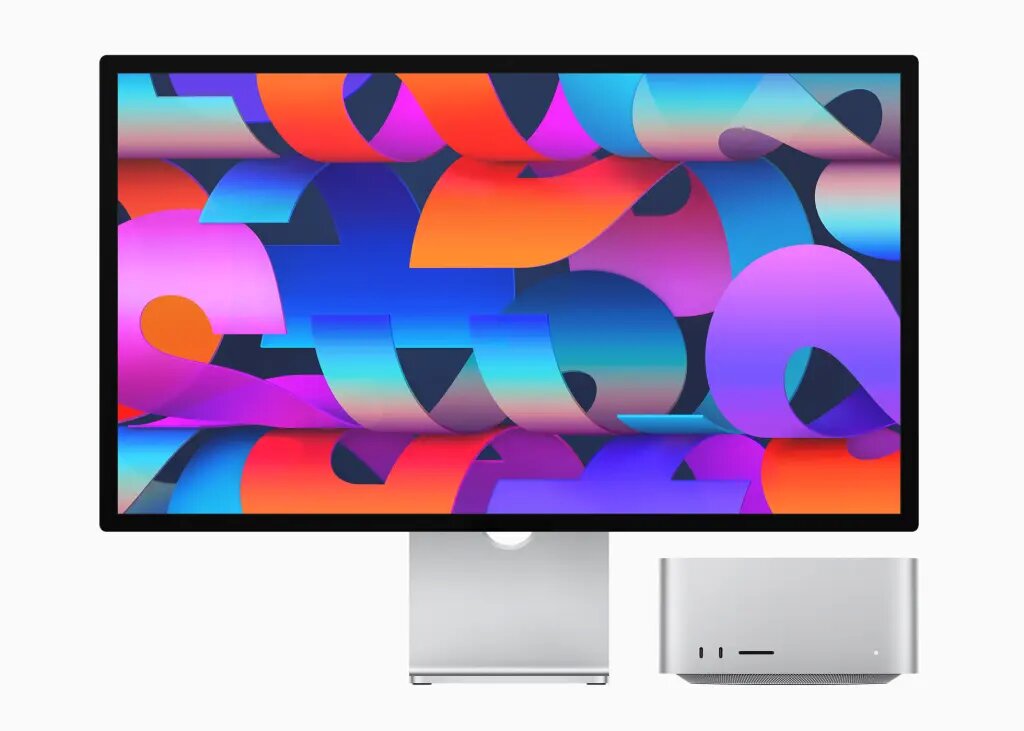A couple of weeks ago, Apple launched its Studio Display, but it’s a bit more than a ‘dumb monitor’. So does that suggest other monitors making that kind of change? Well, I have some views.

The Apple Studio Display is a respectable 5K monitor with 27″ diagonal, but it has something else. The monitor contains an A13 Bionic chip, the same level of chip that was used to drive the iPhone 11 Pro three years ago. The processor is used to make the most of audio and video that is processed through the display and to exploit the integrated camera and microphones.
Over the last few years, good videoconferencing on the desktop has become an important part of display use and having a lot more processing power than a typical monitor should improve the audio visual experience a lot. The monitor includes a 12 megapixel camera and having the A13 chip inside means that the camera can support Apple’s Center Stage feature which adjusts the framing of the image to keep users in the frame.
The processor also supports Spatial Audio in Dolby Atmos compatible content that is delivered through six speakers. It also has three mic arrays and the processor means that they can use directional beamforming to better capture sound. Not only that, the monitor can support Apple’s Siri voice assistant.
All of that is pretty cool, although given the power that’s in the kind of Mac that this monitor will spend its life connected to, I’m not sure why most or all of those functions couldn’t be performed in the Mac. But why not have another processor? Given that the monitor costs from $1,599 (with ‘standard glass’) and from $1,899 with nano-textured glass, Apple can throw in some processing without hitting its bottom line too heavily, especially if buyers opt for the $400 height adjustable stand.
There’s no OS
Although the Studio Display has enough power to run a lot of apps, the display doesn’t include an OS that is app compatible. Om Malik reported on his blog that Apple has said that the monitor is “running a custom-built software system that takes advantage of the latest libraries across the ecosystem”. Malik thinks that this kind of processor used in a monitor is a ‘peek into the future’. I’m not so sure.
It’s not that you couldn’t come up with plenty of ways to use a monitor without having to boot up a system unit. It’s not a new idea, and I’m sure some Apple buyers will adore their displays. But will the idea get adopted more widely? I remain sceptical for two reasons.
First, display vendors have often tried to do a bit more in the display, but companies such as Intel have not really wanted to cede any processing. The CPU and GPU makers like to keep the processing inside the system unit or the graphics board. Putting more processing in the monitor gives more of a share of the system value to the display maker. If this wasn’t the case, you might see more interest in ideas like external GPUs. Putting the GPU in the display could enable some tight display optimisation, but nobody has done it as far as I know.
The second factor is that the bulk of the monitor market is incredibly competitive and price sensitive. Adding processing or ‘smarts’ to a monitor adds cost, not only for the electronics, but for engineering to deal with heat etc. Processors also get out of date pretty quickly. I can see why Apple doesn’t want to put an OS on the chip in its Studio Display. If it did, pretty soon it would be dealing with app compatibilities, security issues, upgrades etc. With fixed functions, that’s not an issue. Unlike many technical devices, software updates for monitors, while not unknown, are rare, in my experience and usually only used to fix problems that turn up in the field.
The other factor about the increased cost is that you get into a kind of what I call a ‘price gravity’ effect. I last wrote about this (Smartphone Opportunities and ‘Price Gravity’) five years ago. My thesis is that you can get a consumer to look at a product that costs a little bit more, but if you ask for a bigger increase, but with limited functions for the increase, the consumer starts to think, wouldn’t I be better buying a cheap monitor and using that extra cost with a bit more money, to buy something full featured?
 There’s a kind of ‘price gravity’ – if the price of a device is too close to a full featured system, the comparison will be with that device and the sale will be lost. Image:Meko
There’s a kind of ‘price gravity’ – if the price of a device is too close to a full featured system, the comparison will be with that device and the sale will be lost. Image:Meko
That has, I think, been part of the problem with a category of product that I had some hopes for a few years ago – shells consisting of a battery, a display and a keyboard, to turn a smartphone into something that looked like a notebook, but exploited the power of the smartphone. The segment struggled with two issues. One of the biggest is that Android is simply not set up to really work with a keyboard and mouse. You can do it, but apps are not optimised. I believe that that is why Apple keeps two OSes for its PCs and its tablets.
The second is that unless a shell product is really a lot cheaper than a PC, the buyer will feel the effect of ‘price gravity’. When I last wrote about this, I was comparing the devices with cheap Windows notebooks, but these days you would have to compare with Chromebooks. That’s a market that is hard to compete with. I lost money when the Andromium kickstarter shell project failed.
So, in conclusion, Apple may well be able to convince some users that the sound and vision features of its new monitor will be worth the money. But most monitor suppliers are not Apple and I doubt that others would be able to do the same thing. (BR)


